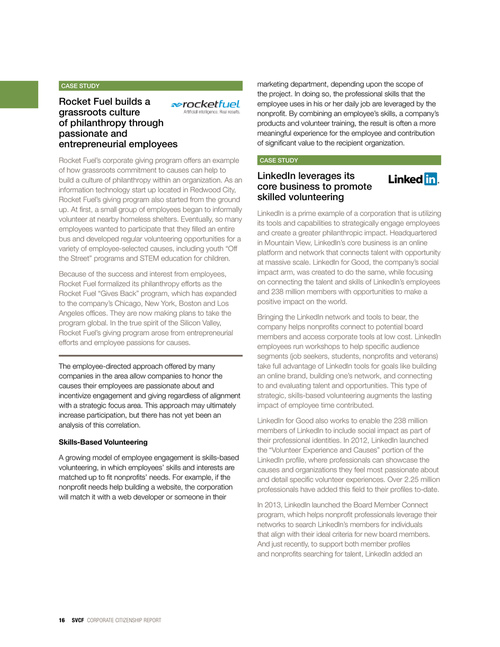
CASE STUDY
Rocket Fuel builds a grassroots culture of philanthropy through passionate and entrepreneurial employees
Rocket Fuel’s corporate giving program offers an example of how grassroots commitment to causes can help to build a culture of philanthropy within an organization. As an information technology start up located in Redwood City, Rocket Fuel’s giving program also started from the ground up. At first, a small group of employees began to informally volunteer at nearby homeless shelters. Eventually, so many employees wanted to participate that they filled an entire bus and developed regular volunteering opportunities for a variety of employee-selected causes, including youth “Off the Street” programs and STEM education for children. Because of the success and interest from employees, Rocket Fuel formalized its philanthropy efforts as the Rocket Fuel “Gives Back” program, which has expanded to the company’s Chicago, New York, Boston and Los Angeles offices. They are now making plans to take the program global. In the true spirit of the Silicon Valley, Rocket Fuel’s giving program arose from entrepreneurial efforts and employee passions for causes. The employee-directed approach offered by many companies in the area allow companies to honor the causes their employees are passionate about and incentivize engagement and giving regardless of alignment with a strategic focus area. This approach may ultimately increase participation, but there has not yet been an analysis of this correlation. Skills-Based Volunteering A growing model of employee engagement is skills-based volunteering, in which employees’ skills and interests are matched up to fit nonprofits’ needs. For example, if the nonprofit needs help building a website, the corporation will match it with a web developer or someone in their
marketing department, depending upon the scope of the project. In doing so, the professional skills that the employee uses in his or her daily job are leveraged by the nonprofit. By combining an employee’s skills, a company’s products and volunteer training, the result is often a more meaningful experience for the employee and contribution of significant value to the recipient organization.
CASE STUDY
Corporations recognize the value of contributions of time and skills for social benefit and have created platforms for employees to contribute back to their communities in meaningful ways.
aspirational question to the “Volunteer Experience and Causes” field: “How would you like to donate your time and talent?” By answering this question, members can signal their interest in skills-based volunteer opportunities and/ or nonprofit board service. Through both employee and member programs, LinkedIn for Good is leveraging the LinkedIn platform to connect individuals with opportunities to use their skills to create a positive impact. Corporations recognize the value of contributions of time and skills for social benefit and have created platforms for employees to contribute to their communities in meaningful ways. For example, the VMware Foundation’s signature initiative is Service Learning, where employees receive 40 paid hours per year to serve in the community and learn through their experience. Knowing that we learn best by “doing”, the concept of Service Learning was inspired by the philosophy of experiential learning in education. The key to this connection is reflecting on the experience. By integrating reflection, with meaningful community service, Service Learning helps enrich the volunteer experience, encourages learning and builds a culture of service that extends beyond employees “dayjobs” to a mindset of lifelong civic engagement. This training also works for leadership roles. Employees often offer to sit on or lead nonprofit boards without the background knowledge necessary to do so effectively. But corporations are starting to include leadership development in their volunteer training or even providing custom board member training so that their leadership team members can effectively lend their expertise as a strategic advisor or board member. Aligning the skills of employees with nonprofits’ needs forms a mutually beneficial relationship for both entities. Employees are motivated by seeing firsthand the value of their work. Nonprofits are able to access expertise that helps them better serve their mission and constituents. This strengthens the relationship between donor and nonprofit, which has led companies to focus on supporting fewer nonprofits but in multiple ways.
LinkedIn leverages its core business to promote skilled volunteering
LinkedIn is a prime example of a corporation that is utilizing its tools and capabilities to strategically engage employees and create a greater philanthropic impact. Headquartered in Mountain View, LinkedIn’s core business is an online platform and network that connects talent with opportunity at massive scale. LinkedIn for Good, the company’s social impact arm, was created to do the same, while focusing on connecting the talent and skills of LinkedIn’s employees and 238 million members with opportunities to make a positive impact on the world. Bringing the LinkedIn network and tools to bear, the company helps nonprofits connect to potential board members and access corporate tools at low cost. LinkedIn employees run workshops to help specific audience segments (job seekers, students, nonprofits and veterans) take full advantage of LinkedIn tools for goals like building an online brand, building one’s network, and connecting to and evaluating talent and opportunities. This type of strategic, skills-based volunteering augments the lasting impact of employee time contributed. LinkedIn for Good also works to enable the 238 million members of LinkedIn to include social impact as part of their professional identities. In 2012, LinkedIn launched the “Volunteer Experience and Causes” portion of the LinkedIn profile, where professionals can showcase the causes and organizations they feel most passionate about and detail specific volunteer experiences. Over 2.25 million professionals have added this field to their profiles to-date. In 2013, LinkedIn launched the Board Member Connect program, which helps nonprofit professionals leverage their networks to search LinkedIn’s members for individuals that align with their ideal criteria for new board members. And just recently, to support both member profiles and nonprofits searching for talent, LinkedIn added an
16
SVCF CORPORATE CITIZENSHIP REPORT
SVCF CORPORATE CITIZENSHIP REPORT
17